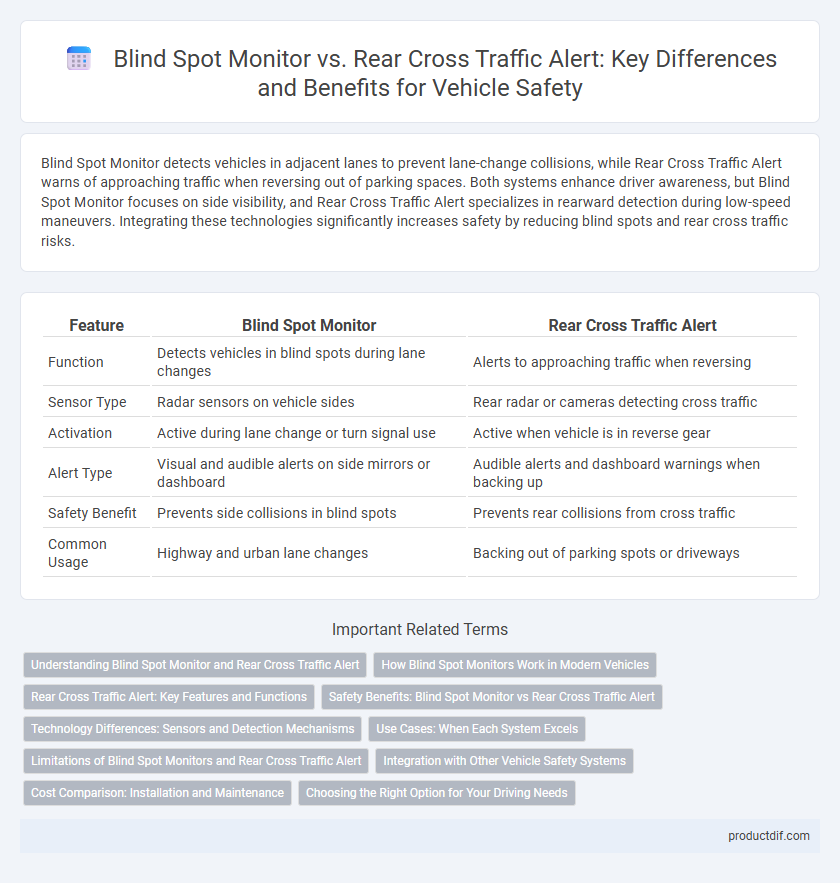Blind Spot Monitor detects vehicles in adjacent lanes to prevent lane-change collisions, while Rear Cross Traffic Alert warns of approaching traffic when reversing out of parking spaces. Both systems enhance driver awareness, but Blind Spot Monitor focuses on side visibility, and Rear Cross Traffic Alert specializes in rearward detection during low-speed maneuvers. Integrating these technologies significantly increases safety by reducing blind spots and rear cross traffic risks.
Table of Comparison
| Feature | Blind Spot Monitor | Rear Cross Traffic Alert |
|---|---|---|
| Function | Detects vehicles in blind spots during lane changes | Alerts to approaching traffic when reversing |
| Sensor Type | Radar sensors on vehicle sides | Rear radar or cameras detecting cross traffic |
| Activation | Active during lane change or turn signal use | Active when vehicle is in reverse gear |
| Alert Type | Visual and audible alerts on side mirrors or dashboard | Audible alerts and dashboard warnings when backing up |
| Safety Benefit | Prevents side collisions in blind spots | Prevents rear collisions from cross traffic |
| Common Usage | Highway and urban lane changes | Backing out of parking spots or driveways |
Understanding Blind Spot Monitor and Rear Cross Traffic Alert
Blind Spot Monitor uses sensors to detect vehicles in adjacent lanes that may not be visible in the side mirrors, enhancing driver awareness and preventing lane-change collisions. Rear Cross Traffic Alert scans for approaching traffic from the sides when reversing, alerting drivers to potential hazards not visible through the rearview camera. Both systems integrate radar and camera technology to provide critical safety information during low-visibility driving scenarios.
How Blind Spot Monitors Work in Modern Vehicles
Blind Spot Monitors in modern vehicles use radar sensors or cameras mounted on the sides and rear to detect vehicles in adjacent lanes that may not be visible in side mirrors. These systems alert drivers through visual indicators on the side mirrors or audible warnings when a vehicle is detected in the blind spot during lane changes. By continuously monitoring the vehicle's surroundings, Blind Spot Monitors enhance safety by reducing the risk of collisions from unseen vehicles.
Rear Cross Traffic Alert: Key Features and Functions
Rear Cross Traffic Alert enhances vehicle safety by detecting approaching vehicles from the sides when reversing, using radar sensors mounted on the rear corners. This system alerts drivers with visual and audible warnings to prevent collisions in parking lots or driveways. Its key functions include monitoring blind spots behind the vehicle and providing timely alerts even in low visibility conditions.
Safety Benefits: Blind Spot Monitor vs Rear Cross Traffic Alert
Blind Spot Monitor enhances safety by detecting vehicles in adjacent lanes, reducing the risk of side collisions during lane changes. Rear Cross Traffic Alert improves awareness when reversing by warning drivers of approaching traffic from the sides, preventing potential rear-end accidents in parking lots. Together, these systems provide comprehensive situational awareness, significantly lowering the likelihood of blind spot and rear collision incidents.
Technology Differences: Sensors and Detection Mechanisms
Blind Spot Monitor (BSM) utilizes radar sensors positioned on the vehicle's side mirrors or rear corners to detect vehicles in adjacent lanes, providing alerts when changing lanes is unsafe. Rear Cross Traffic Alert (RCTA) employs sensors, often radar or ultrasonic, mounted on the rear bumper to identify approaching traffic from the sides while reversing. The primary technological difference lies in BSM's lateral blind zone detection versus RCTA's rearward cross traffic detection, each optimized for distinct driving scenarios.
Use Cases: When Each System Excels
Blind Spot Monitor excels in detecting vehicles in adjacent lanes during lane changes, enhancing safety on highways and busy roads. Rear Cross Traffic Alert is most effective when backing out of parking spaces or driveways, alerting drivers to cross traffic that may be obscured from view. Both systems complement each other by addressing different blind spot risks in everyday driving scenarios.
Limitations of Blind Spot Monitors and Rear Cross Traffic Alert
Blind Spot Monitors often struggle with detecting smaller objects like motorcycles or bicycles, especially in adverse weather conditions or heavy traffic, limiting their effectiveness. Rear Cross Traffic Alert systems may fail to identify fast-approaching vehicles or pedestrians during tight parking maneuvers, particularly in crowded or poorly lit environments. Both systems rely heavily on sensor technology, which can be compromised by dirt, snow, or sensor misalignment, reducing overall reliability.
Integration with Other Vehicle Safety Systems
Blind Spot Monitor seamlessly integrates with lane-keeping assist and adaptive cruise control to enhance situational awareness and prevent side collisions. Rear Cross Traffic Alert works in conjunction with rear parking sensors and automatic emergency braking to detect and respond to approaching vehicles during reverse maneuvers. Both systems share sensor data with the vehicle's central safety platform, enabling coordinated responses that improve overall driving safety.
Cost Comparison: Installation and Maintenance
Blind Spot Monitor systems typically have higher installation costs due to advanced radar sensors and integration with side mirrors, often ranging from $400 to $700, while Rear Cross Traffic Alert can be less expensive, averaging $300 to $500. Maintenance expenses for both systems are generally low but may increase if sensor calibrations or replacements are needed, with Blind Spot Monitors potentially incurring slightly higher service fees due to their complexity. Choosing between the two depends on budget constraints and the specific safety features prioritized by the vehicle owner.
Choosing the Right Option for Your Driving Needs
Blind Spot Monitor enhances safety by alerting drivers to vehicles in adjacent lanes during lane changes, reducing side collision risks. Rear Cross Traffic Alert warns of approaching traffic when reversing, ideal for parking lot navigation and tight spaces. Selecting the right system depends on your driving environment; prioritize Blind Spot Monitor for highway driving and Rear Cross Traffic Alert for urban or congested areas.
Blind Spot Monitor vs Rear Cross Traffic Alert Infographic

 productdif.com
productdif.com